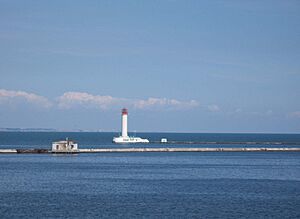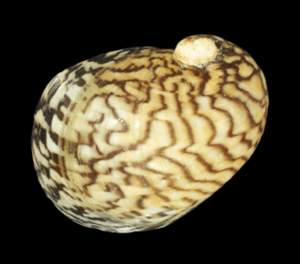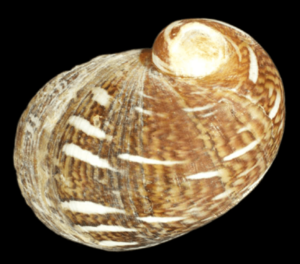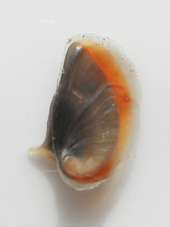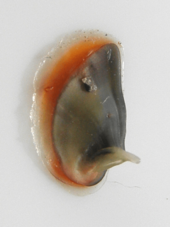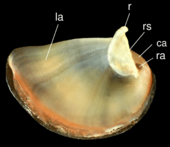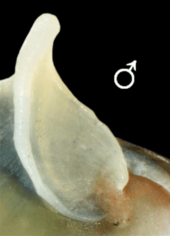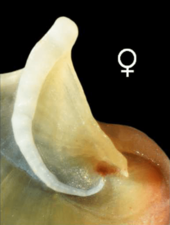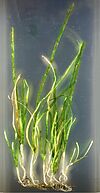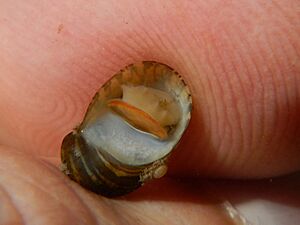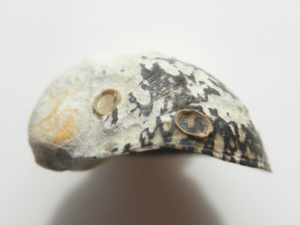Theodoxus fluviatilis facts for kids
Quick facts for kids Theodoxus fluviatilis |
|
|---|---|
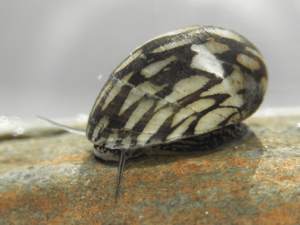 |
|
| A live River Nerite snail | |
| Conservation status | |
| Scientific classification | |
| Synonyms | |
|
The river nerite, Theodoxus fluviatilis, is a small snail that lives in both freshwater and brackish water. It has a gill and a special lid called an operculum to close its shell. This aquatic snail is a type of gastropod mollusk and belongs to the family Neritidae.
This snail is found in many places, from Europe all the way to Central Asia. It has a strong shell, and its patterns and colors can change a lot. Theodoxus fluviatilis lives in rivers and lakes, usually clinging to stones. It mostly eats by scraping off biofilms and tiny algae called diatoms.
Some groups of these snails are growing quickly. They can reach very high numbers, sometimes thousands of snails in just one square meter. Female snails lay egg capsules. Each capsule has many eggs, but only one baby snail hatches from it. These snails become adults in about a year and usually live for 2 or 3 years.
Contents
Understanding the River Nerite Snail
The river nerite, Theodoxus fluviatilis, was first described by Carl Linnaeus in 1758. He gave it the name Nerita fluviatilis. Linnaeus's original description was very short and in Latin.
It said: "Nerita fluviatilis, number 632: the shell is wrinkled, there are no teeth in the opening. It lives in rivers in Europe." Later, this snail was moved to a different group called Theodoxus. In fact, Theodoxus fluviatilis is the main example for the Theodoxus group.
Different Types of River Nerites
Scientists have described several different types, or subspecies, of Theodoxus fluviatilis. These include:
- Theodoxus fluviatilis fluviatilis (Linnaeus, 1789) – found in freshwater.
- Theodoxus fluviatilis littoralis (Linnaeus, 1789) – found in brackish water. Even though these two forms look different and live in different places, they are likely just variations of the same species that have adapted to their environment.
- Theodoxus fluviatilis sardous (Menke, 1830)
- Theodoxus fluviatilis subthermalis Issel, 1865
- Theodoxus fluviatilis thermalis (Dupuy, 1851)
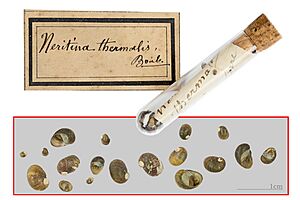 Syntypes of Theodoxus fluviatilis thermalis at MHNT
Syntypes of Theodoxus fluviatilis thermalis at MHNT - Theodoxus fluviatilis transversetaeniatus A. J. Wagner, 1928
- Theodoxus fluviatilis dalmaticus Sowerby – found in Lake Ohrid.
- Theodoxus fluviatilis euxinus (Clessin, 1885)
Where River Nerites Live
The exact first place this snail was found is not known. It might be the Main river in Southern Germany. This snail is found across Western and Central Palaearctic regions. This means it lives in many parts of Europe and Western Asia. It is not found in Norway or Siberia.
Theodoxus fluviatilis has the widest distribution of all snails in its group. It is one of the most widespread snails in its entire family.
These snails are sometimes at risk because of changes to rivers and water pollution. In some areas, their numbers are going down, like in Germany. But in other places, like the Danube river, their numbers are growing. For example, in the Rhine river, they almost disappeared in the 1970s due to pollution. After the water got cleaner, they came back. However, they disappeared again in the late 1990s for unknown reasons. Since 2006, they have returned to the Rhine. They likely traveled there by ship transport through the Main-Danube Canal.
European Homes of the River Nerite
This snail is common in Western Europe. It is also widespread in northern Ireland. It lives in 10% of Irish streams and rivers.
You can find it in Great Britain, the Orkney Islands, and the Netherlands. It also lives in Belgium, Luxembourg, Liechtenstein, and Monaco. In France and Switzerland, it is considered critically endangered. Further south, it is in Spain and Portugal.
In Central Europe, it was recently found in the Austrian Danube in 2001. In the Czech Republic, it is now extinct. It also lives in Poland, Slovakia, and Hungary. In Germany, it used to be in all large rivers like the Rhine and Elbe. Now, it is highly endangered there.
In Northern Europe, it is in Denmark and Sweden. It is also on the coasts of Finland and in Åland. No other Theodoxus snail lives as far north as this one. In Eastern Europe, it is in Estonia, Lithuania, and Latvia. It is also in Belarus and parts of Russia. Since 1997, it has been found in the Gulf of Odesa, Ukraine. In Ukraine and Crimea, it is not native. It also lives in Moldova. In Southern Europe, it is in Albania, Bosnia and Herzegovina, Romania, Bulgaria, Slovenia, and Croatia. It is found in Lake Ohrid as a subspecies. It also lives in Greece, Crete, Italy, and Serbia.
River Nerites in Asia and Africa
In Asia, Theodoxus fluviatilis is found in Turkey. It also lives in Iran in several provinces. In Africa, this snail is found in Algeria. It might also live in Morocco.
Ancient History of River Nerites
Shells of Theodoxus fluviatilis have been found at very old archaeological sites. These sites date back to the Stone Age in Portugal and the Åland Islands. This suggests that the snail's original home was likely around the Ponto-Pannonian region. Scientists think it first spread to Italy, Greece, and Turkey. Then it moved to Spain, France, and Germany. Finally, in more recent times, it reached the British Isles, Sweden, and the Baltic Sea.
What River Nerites Look Like
The shell of Theodoxus fluviatilis is usually flat with a low spiral top. It is very strong and has 3 to 3.5 turns. Older snails often have worn-down shells. An adult shell is usually 5–9 mm wide, but can be up to 11–13 mm. The shell's height is 4–6.5 mm, or up to 7 mm. These sizes can vary depending on where the snail lives.
The outside of the shell is usually whitish or yellowish. It has a dark reddish or violet pattern that looks like a net. This pattern can change a lot. Sometimes it has bands, and sometimes it's just dark. The shell's color and patterns are very varied. These patterns can be affected by things like water chemistry, the type of surface the snail lives on, and what it eats. For example, in the Baltic Sea, snails in open coastal waters are often nearly black. But in sheltered areas, they are more yellowish-green. Snails from dark, stony places are often black or dark brown.
Snails from Northern Europe have white, drop-like spots on a dark or red background. Snails from Southern France and Spain have zigzag stripes. Those from the Balkans can have a mix of both. Snails living in lakes often have dark or light bands on their shells.
Images showing variability in the color patterns of shells of Theodoxus fluviatilis:
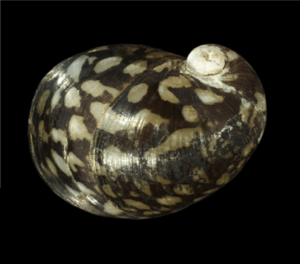
From Alster, Germany.
|
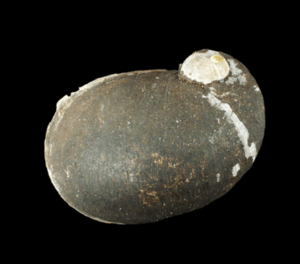
From Güstrow, Germany.
|
The shell shape of Theodoxus fluviatilis is similar to Theodoxus transversalis. The shell of Theodoxus danubialis is more round. It can be hard to tell these species apart because their shells can look so different. However, the overall shape is still used to identify them.
The operculum, or "lid," of T. fluviatilis is D-shaped. It is light reddish with a red edge. It has a wide ridge on its inner side. This ridge is where the snail's muscle attaches. The operculum's features are clear even in young snails. Males and females have a slight difference in the shape of this ridge. It is straight in females but curved in males.
The soft parts of the snail that you can see are light yellow with a black head. Its tentacles are grayish and long. The eyes are large and black. Its foot, which it uses to move, is whitish.
How River Nerites Eat

Like other snails in its family, Theodoxus fluviatilis has a special tongue-like organ called a radula. This radula has many tiny teeth that help the snail scrape food particles into its mouth. They mainly eat diatoms that grow on stones. They also scrape off biofilms and eat detritus (dead organic material). They can also eat Cyanobacteria and green algae, but these are not their preferred foods.
Life Cycle and Habitat of River Nerites
Habitat and Environment
Theodoxus fluviatilis prefers low-lying areas and waters rich in calcium. This small snail lives in the middle and lower parts of rivers, sometimes as deep as 13 meters. It can also be found in brackish water in tidal rivers and estuaries. Sometimes, it lives in lakes on bare bottoms. Rarely, it lives in springs or caves. For example, in the Åland Islands, these snails were found in lakes with a pH of 7.8–8.9. In Irish streams, they lived in water with a pH of 7.0–8.4.
The snail can easily stick to stones. This allows it to live in fast-moving water and in wavy parts of lakes. Its ability to live in both freshwater and brackish water shows how adaptable it is. This small snail can live up to 60 meters deep in coastal waters. Brackish water snails can handle salt levels up to 15‰ or even 18‰ in the Baltic and Black Seas. Snails from brackish water can tolerate more salt than those from freshwater.
This species lives on hard surfaces like rocks and pebbles. It can handle some mild pollution and low oxygen levels. However, it cannot survive long droughts or ice. It lives in mesotrophic waters, which have a moderate amount of nutrients.
Theodoxus fluviatilis is used as an indicator species for monitoring rivers in Germany. This means its presence can tell us about the river's health. However, spreading populations can also live in degraded habitats. It has a large ability to adapt. It lives on stones and dead wood in freshwater. In brackish water, it lives on stones and on plants like Fucus vesiculosus and Zostera marina.
This snail, along with a type of crustacean called Saduria entomon, makes up a large part of the animal weight in the central and northern Baltic Sea. In brackish water, there can be 200–1000 snails per square meter. In Lake Ohrid, there can be up to 6412 snails per square meter. In one spring in Portugal, there were up to 9000 snails per square meter. This spring has a stable temperature, allowing the snails to reproduce all the time.
Reproduction and Life Cycle
Theodoxus fluviatilis snails have separate sexes; each snail is either male or female.
Female snails usually lay eggs from mid-April to October, when temperatures are above 10 °C. They lay egg capsules on stones and sometimes on the shells of other snails. A female usually lays a group of 4–5 capsules. One female might lay about 40 capsules in summer and 20 in autumn. New capsules are white, but they turn yellow or brown as they get older. The capsules are about 1 mm wide, but in brackish water, they are usually smaller.
The number of eggs in each capsule changes with the environment. There are 100–200 eggs in freshwater capsules, but 55–80 eggs in brackish water capsules. Usually, only one egg develops into a snail. The other eggs provide food for the growing embryo. This means only one baby snail hatches from each capsule.
Young snails, about 0.5–1 mm long, hatch after 30 days at 25 °C, or after 65 days at 20 °C. Capsules laid in spring hatch after 2–3 months. Capsules laid in late summer will stay through winter because development stops below 10 °C. These capsules hatch in spring after 7–8 months. The snail's shell grows mostly from May to August and stops growing in winter. Snails become adults in less than 1 year, when their shell is about 5.5–5.7 mm long.
The river nerite usually lives for 2–3 years. Some snails have been estimated to live up to 3.5 years. Fewer snails die in summer. However, more die in winter because ice and storms can move the stones they live on, which can hurt the snails.
Enemies and Health of River Nerites
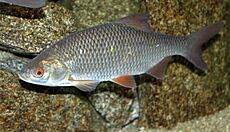
Theodoxus fluviatilis can be affected by tiny organisms called trematodes, which are a type of parasite. The snail acts as a host for some of these parasites. It is also a host for several types of ciliates, which are tiny single-celled organisms. For example, it is the main host for the ciliate Trichodina baltica.
Fish like the common roach (Rutilus rutilus) eat Theodoxus fluviatilis. Some birds also prey on these snails.



